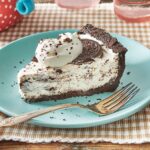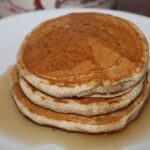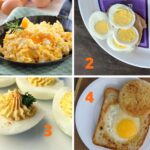Unlock a world of culinary creativity with our guide to egg-free cooking! Imagine flawlessly smooth sauces, fluffy cakes, and satisfying breakfasts, all without relying on eggs. This comprehensive guide unveils ingenious substitutions, innovative techniques, and delicious recipes that will revolutionize your kitchen and expand your culinary horizons. Discover how to effortlessly adapt your favorite recipes, conquer common egg-free cooking challenges, and unlock a new level of culinary mastery.
From mastering the art of egg-free baking, where you’ll learn to create light and airy cakes using ingenious substitutes, to crafting creamy sauces and dressings that rival their egg-laden counterparts, this guide provides a step-by-step journey into a world of delicious egg-free possibilities. We’ll explore vibrant breakfast options bursting with flavor and nutrition, and equip you with the knowledge and confidence to transform any recipe into an egg-free masterpiece. Prepare to be amazed by the versatility and deliciousness of egg-free cooking!
Egg-Free Sauces and Dressings
Creating delicious and creamy sauces and dressings without eggs might seem challenging, but with the right techniques and ingredients, it’s entirely achievable. Egg-free alternatives offer versatility and cater to various dietary needs, opening up a world of culinary possibilities. This section explores three egg-free sauce recipes, highlighting the role of alternative emulsifiers and comparing their textures and flavors to their traditional counterparts.
Egg-Free Mayonnaise
This recipe utilizes a simple yet effective method to create a creamy, stable mayonnaise without relying on eggs. The key is a good quality oil and a powerful immersion blender.
Ingredients:
- 1 cup neutral-flavored oil (e.g., grapeseed, avocado)
- 1/4 cup water
- 2 tablespoons lemon juice
- 1 tablespoon Dijon mustard
- 1 teaspoon salt
- 1/2 teaspoon black pepper
Instructions:
- Combine water, lemon juice, mustard, salt, and pepper in a tall, narrow container.
- Slowly drizzle in the oil while blending continuously with an immersion blender. The emulsion will begin to thicken as the oil incorporates.
- Continue blending until the mayonnaise is thick and creamy. Adjust seasoning to taste.
Egg-Free Hollandaise
Traditional hollandaise relies heavily on eggs for its emulsifying properties. This recipe substitutes aquafaba (chickpea brine) for a surprisingly similar result.
Ingredients:
- 1/2 cup aquafaba (liquid from a can of chickpeas)
- 1/2 cup unsalted butter, melted
- 1 tablespoon lemon juice
- 1/4 teaspoon salt
- Pinch of cayenne pepper (optional)
Instructions:
- Whisk aquafaba in a heatproof bowl until frothy.
- Slowly drizzle in the melted butter while whisking constantly. The mixture will thicken.
- Stir in lemon juice, salt, and cayenne pepper (if using).
- Keep warm over a double boiler or very low heat, stirring occasionally, until ready to serve.
Egg-Free Aioli
This garlicky sauce utilizes the natural emulsifying properties of mustard and a high-quality oil to create a rich and flavorful aioli.
Ingredients:
- 1/2 cup neutral-flavored oil (e.g., grapeseed, avocado)
- 2 cloves garlic, minced
- 1 tablespoon Dijon mustard
- 1 tablespoon lemon juice
- 1/2 teaspoon salt
- 1/4 teaspoon black pepper
Instructions:
- Combine garlic, mustard, lemon juice, salt, and pepper in a tall, narrow container.
- Slowly drizzle in the oil while blending continuously with an immersion blender. The emulsion will thicken as the oil incorporates.
- Continue blending until the aioli is thick and creamy. Adjust seasoning to taste.
Comparison of Egg-Free and Traditional Sauces
The following table compares the texture and flavor profiles of egg-free and traditional versions of the sauces.
| Sauce | Egg-Free Version | Traditional Version |
|---|---|---|
| Mayonnaise | Slightly less creamy than traditional mayonnaise, but still smooth and emulsified; similar tangy flavor. | Creamier, richer texture; slightly tangier flavor due to egg yolks. |
| Hollandaise | Slightly less rich and glossy than traditional hollandaise; similar lemony flavor, but may lack the same richness. | Very rich, glossy, and creamy texture; pronounced buttery and lemony flavor. |
| Aioli | Similar creamy texture to traditional aioli; identical strong garlicky flavor. | Creamy texture; strong garlicky flavor. |
Achieving Creamy Texture in Egg-Free Sauces
Achieving a creamy texture in egg-free sauces hinges on proper emulsification and the strategic use of fats and starches. High-quality oils provide richness and aid in emulsification. Starches, such as cornstarch or arrowroot powder, can be used to thicken the sauce, but must be added gradually to avoid lumps. Additionally, using a powerful immersion blender ensures a smooth, homogenous texture by thoroughly incorporating the oil into the other ingredients.
Mastering Egg-Free Cooking Techniques

Embarking on an egg-free culinary journey presents unique challenges, but mastering a few key techniques can unlock a world of delicious, versatile dishes. Understanding the role eggs play in traditional recipes – binding, leavening, and emulsifying – is crucial to finding suitable replacements and achieving comparable results. This section will explore common difficulties and offer practical solutions, ultimately empowering you to create egg-free masterpieces.
Common Challenges and Solutions in Egg-Free Cooking
The absence of eggs significantly alters the texture and structure of many dishes. Successfully navigating egg-free cooking requires understanding these changes and employing appropriate substitutions.
- Challenge: Binding ingredients together. Eggs act as a natural binder, holding ingredients together in dishes like meatballs or fritters. Solution: Use mashed bananas, applesauce, flaxseed meal (mixed with water), or mashed chickpeas as effective binders. The choice depends on the desired flavor and texture.
- Challenge: Achieving adequate leavening in baked goods. Eggs contribute to the rise and airy texture of cakes and pancakes. Solution: Utilize baking powder or baking soda in combination with acidic ingredients like lemon juice or vinegar to create a chemical leavening reaction. Alternatively, incorporate whipped aquafaba (chickpea brine) for a similar effect to egg whites.
- Challenge: Creating stable emulsions in sauces and dressings. Eggs are excellent emulsifiers, preventing separation in vinaigrettes and sauces. Solution: Use a high-quality emulsifier like mustard or a well-whisked combination of oil and vinegar, gradually adding the oil in a slow, steady stream while whisking vigorously. Consider using a blender for smoother results.
- Challenge: Maintaining moisture in baked goods. Eggs help retain moisture, preventing dryness. Solution: Add extra oil or applesauce to egg-free recipes to compensate for the moisture loss. Using a higher ratio of liquid to dry ingredients can also help.
Impact of Egg Absence on Culinary Properties
The absence of eggs necessitates adjustments in various aspects of cooking. The binding properties, essential for cohesion in dishes like meatballs and fritters, are typically replaced by using starches, pureed fruits, or legumes. Leavening, crucial for the airy texture of cakes and pancakes, relies on chemical leavening agents or alternative foams like aquafaba. Emulsification, responsible for the stability of sauces and dressings, requires careful technique and possibly the addition of emulsifying agents like mustard. Finally, the moisture retention provided by eggs needs to be compensated for with additional liquid or fats in baked goods.
Fluffy Egg-Free Pancakes: A Step-by-Step Guide
Creating light and fluffy pancakes without eggs requires careful attention to technique. The following steps Artikel a method that utilizes alternative binding and leavening agents to achieve a desirable texture.
- Combine dry ingredients: In a large bowl, whisk together 1 ½ cups all-purpose flour, 2 tablespoons sugar, 2 teaspoons baking powder, and ½ teaspoon salt. Ensure all ingredients are evenly distributed.
- Combine wet ingredients: In a separate bowl, whisk together 1 cup milk (dairy or non-dairy), 2 tablespoons melted oil (vegetable or coconut), 1 teaspoon vanilla extract, and 1 tablespoon apple sauce. The applesauce acts as a binder and adds moisture.
- Gently combine wet and dry ingredients: Gradually add the wet ingredients to the dry ingredients, whisking gently until just combined. Overmixing will develop the gluten in the flour, resulting in tough pancakes. The batter should be slightly lumpy.
- Cook the pancakes: Heat a lightly oiled griddle or frying pan over medium heat. Pour ¼ cup of batter onto the hot surface for each pancake. Cook for 2-3 minutes per side, or until golden brown and cooked through. The pancakes should be fluffy and tender.
- Serve immediately: Serve your egg-free pancakes warm, with your favorite toppings such as maple syrup, fruit, or whipped cream.
Embarking on an egg-free culinary adventure opens doors to a world of flavor and innovation. With the right techniques and substitutions, you can create dishes that are not only delicious but also cater to dietary needs and preferences. From the perfectly textured pancakes to the rich and creamy sauces, this guide has equipped you with the skills and knowledge to confidently navigate the world of egg-free cooking. So, embrace the challenge, experiment with new ingredients, and discover the joy of creating amazing meals without eggs. Your culinary journey awaits!
FAQ Insights
Can I freeze egg-free baked goods?
Yes, many egg-free baked goods freeze well. Wrap them tightly in plastic wrap and then foil before freezing for optimal quality.
What are the best egg substitutes for binding?
Flaxseed meal, chia seeds, and mashed banana are excellent binders in egg-free baking and cooking. The amount needed will vary depending on the recipe.
How do I prevent my egg-free pancakes from being gummy?
Ensure your batter isn’t too wet; over-mixing can also lead to gummy pancakes. Use a good quality flour blend and don’t overcrowd the pan when cooking.
Are all egg-free recipes suitable for vegans?
Not necessarily. Some egg substitutes may contain dairy or other non-vegan ingredients. Always check the ingredients list of any substitute you use.


